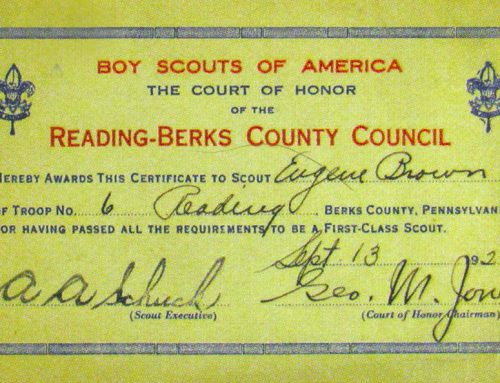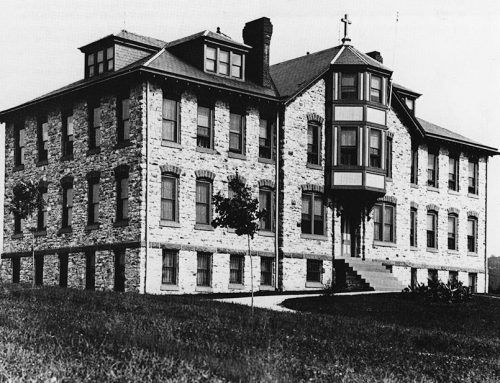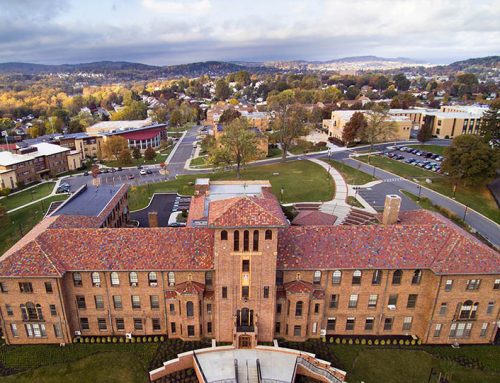In the nineteenth century there was not the network of government sponsored social service agencies that are in place today. When needs arose, they were generally taken care of by families, benevolent societies, or by religious institutions. In the nineteenth century and for a large part of the twentieth century, many social services were provided by religious institutions to both care for those in need, and to preserve and promulgate the faith. Catholic parishes and dioceses were at the forefront of establishing many social service institutions such as schools, hospitals, homes for the aged, as well as orphanages. These institutions would not have formed without the dedicated service of women religious that staffed the educational and care facilities. In many ways, the story of the growth of Catholic schools, orphanages, and hospitals is the story of the growth of religious communities in the United States.
The care of homeless and unwanted children was one such need in Reading. As the population in Reading and Berks County began to grow with the increase in the number of immigrants, so did the need for facilities to care for children who had no one to care for them.
In 1889, Father Bornemann, rector of St. Paul’s R.C. Church, Reading, PA, purchased several properties on North Ninth Street adjacent to the St. Paul’s Convent for the purpose of establishing a home for orphaned boys. The facility would be financed and operated by St. Paul’s parish under the oversight of Father Bornemann. The Sisters of Christian Charity, who staffed St. Paul’s School, would initially oversee the home. After several years of operation, on December 21, 1896, the deed for the property that housed St. Paul’s Orphanage was transferred to Archbishop Patrick John Ryan representing the Archdiocese of Philadelphia. In consideration for the transfer, the parish received $10,000.
Below: St. Paul’s Convent, left. St. Paul’s Orphan Asylum for Boys, right.

The orphanage continued to grow and by 1915 there were approximately 125 boys sheltered in the orphanage under the sponsorship of St. Paul’s Parish. Eventually, the task of staffing the school and the orphanage became too much of a challenge for the Sisters of Christian Charity, and Father Bornemann asked the Missionary Sisters of the Sacred Heart of Jesus to come to Reading and run the orphanage.
In the latter years of Monsignor Bornemann’s life, St. Paul’s Orphan Asylum for Boys was in need of renovation or relocation. The orphanage had been near and dear to his heart, but as his health declined, the orphanage did not receive the attention that was needed for facilities upkeep. Unable to fulfill this need during his life, he left a substantial amount in his will for the orphanage. A provision in his will declared that should St. Paul’s Orphanage close; the funds should be used to construct a memorial chapel at Gethsemane Cemetery.
Local authorities did not press the issue of the condition of the orphanage during Monsignor Bornemann’s life due to their admiration and respect for him. However, after he passed it was made clear that substantial improvements needed to be made to the facility. Sister M. Afra, MSC, in reviewing her time at St. Paul’s Orphanage, remembered an inspection by a city official prior to the passing of Monsignor Bornemann. The inspector commented that the four city buildings were not suitable for the use as an orphanage, but that nothing would be done so long as Monsignor Bornemann was alive because of the deep respect for Monsignor Bornemann, and for all he had done for the city and its people. However, he further explained that when Monsignor Bornemann died, the orphanage must be closed or rebuilt to acceptable standards.
The new pastor of St. Paul’s following Monsignor Bornemann’s death, Father Theodore Hammeke, was left with a dilemma regarding the orphanage. The facility was crowded and in desperate need of renovation. St. Paul’s Parish needed to significantly upgrade the facility at 135 North Ninth Street, find more suitable accommodations, or close the orphanage. The parish was not able to meet the operational expenses of the orphanage, let alone have the funds to renovate the existing building or purchase a new building. In July 1925, Father Hammeke asked a group of St. Paul’s parishioners to advise him regarding the future of the St. Paul’s Orphanage for Boys. At that time, there were 75 boys in the orphanage, overseen by eight Sisters of the Sacred Heart of Jesus. Influencing the decision may have been that fewer boys were from St. Paul’s Parish, and it was perceived that a growing number of these boys were placed in the institution out of convenience for the parents, rather than true need. Given the challenges, and upon advisement of the parishioner group, Father Hammeke closed St. Paul’s Orphan Asylum for Boys in 1925, just one year after Monsignor Bornemann’s death, and placed the boys in other institutions. By July 1925, homes had been found for about half of the boys in other orphanages or in private homes. Thus, it was that the orphanage was closed and the buildings used for other activities of the parish.






Leave A Comment